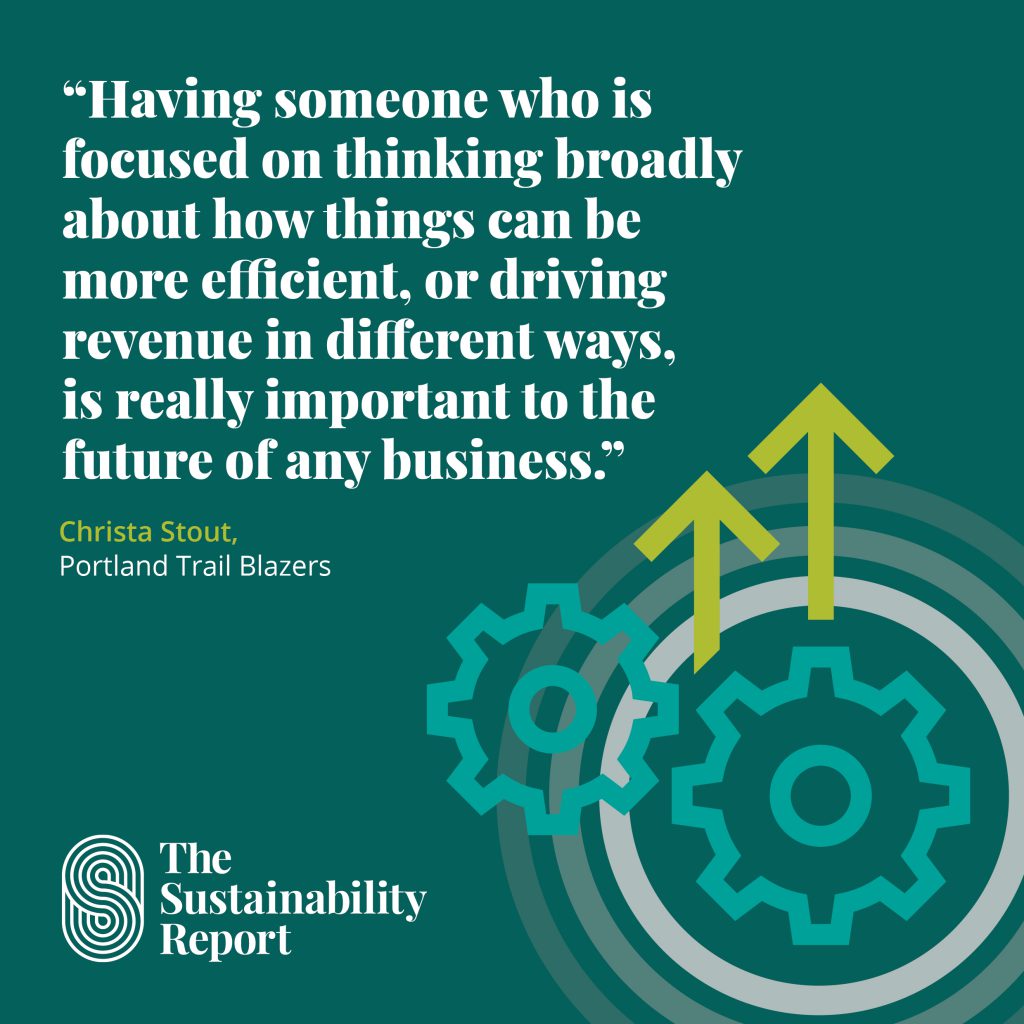Although not yet mainstream, the position has the potential to emerge as the industry’s most influential, with responsibility stretching from technology adoption and fan engagement to revenue generation and sustainability
When Spanish soccer team Real Madrid unveiled an ambitious expansion of its retail estate in partnership with Leaders (the ‘premium experiences’ joint venture between the Dallas Cowboys and New York Yankees) earlier this week, it represented the coming together of the three most valuable sports teams in the world.
According to Forbes’ 2019 list of the 50 most valuable entities in the industry, the Cowboy, the Yankees and Real had a combined value of almost $15bn.
It’s an astronomical sum, especially when taking into account sport’s position less than a decade ago. In 2012, only one team (Manchester United) had a value of more than $2bn. Now, every single team on the list is worth at least that amount.
This “skyrocketing” of sports team valuations has been built on the “backs of ballooning media rights deals”, says Forbes and, before Covid-19 pulled the rug from under the industry’s feet, everything was looking rosy.
But a more thorough look under the hood is required. Even before the pandemic struck, sport was having to face up to some significant challenges. The inflated broadcast rights that elevated five English Premier League teams to the top 50, for example, appear to have peaked and are expected to decrease. In the US, high school sports participation dropped for the first time in 30 years in 2019. And all four major American sports leagues – NFL, MLB, NBA, NHL – saw a decline in total fan attendance between 2008 and 2018.
Sports Innovation Lab (the sport research centre co-founded by Olympic gold medallist Angela Ruggiero) has identified 2020 and beyond as the “age of the ‘fluid fan’” – fans that are more open to change, empowered to choose, and continuously evolving. They are more prone to switching allegiances, they prioritise values and are creators as well as consumers.
Capturing the imagination of this new generation of fans and participants is crucial to the survival of sports teams, leagues and federations. But to do so will require significant organisational and mindset shifts, articulated well by the ‘fluid fan’ research.
Three new rules to fan engagement have been conceptualised: design for behaviours, not engagement; invest in enabling technology; and embrace agility.
Incorporating these rules into organisational norms is easier said than done, however, and it takes a person (or people) with the right skillset and vision to address the challenges faced by a team or league, and find the solutions that no one else can see.
“Sport, historically, has been insular and relied on the same sources of income – tickets, sponsorship, broadcast, merchandise, and food and beverage – but now technology is completely reshaping the industry,” Ruggiero tells The Sustainability Report. “There is a need for teams and leagues to have someone who understands technology, innovation, and how the traditional business of sport might be shifting.
“There are tonnes of opportunities for new revenue generation, for fan engagement, and ways to operate. It’s becoming more like running a media business than a sports team.”
And the person best able to help sports entities navigate through this evolving reality, and address the most pressing challenges and opportunities it throws up, Ruggiero adds, should be in the form of a chief innovation officer.
Opportunities
In his book, The Innovation Mandate: The Growth Secrets of the Best Organizations in the World, Nicholas Webb suggests that the term ‘chief innovation officer’ was first coined in the 1998 book Fourth Generation R&D: Managing Knowledge, Technology and Innovation. In Webb’s words, successful chief innovation officers “focus on managing the innovation process inside the organisation, which includes identifying strategies, business opportunities and new technologies, and then developing new capabilities and architectures with partners, new business models, and new industry structures to serve those opportunities.”
Building on Webb’s definition, a Harvard Business Review article penned by Darko Lovric and Greig Schneider identified six different types of chief innovation officer: researchers (that focus on scientific methodology), engineers (hands-on explorers), investors (careful allocators of resources), advocates (a strong sense of fashion), motivators (cultural change makers), and organisers (process-focused).
Indeed the role is a difficult one to define narrowly because innovation can mean different things for different organisations.
For Ruggiero, a successful chief innovation officer in sport needs to have an eye for the best ideas, an understanding of how to allocate and protect a budget for “potentially disruptive ideas”, an understanding of the shifting media and sponsorship landscapes, and look at what’s happening on the field of play.
“Media is evolving and media disruption should be part of their purview. Brands are changing the way they measure return on investment of sponsorship,” she adds. “This person should think about athlete healthcare and performance, and how data and wearables are moving into sport. They have to be constantly curious and have their finger on the pulse across all these product areas.”
Essentially, the chief innovation officer of any organisation needs to cultivate solutions to emerging problems, help the company adapt to shifting consumer demands and differentiate the brand from competitions.
So what does that look like in sport? Obviously, the current problem facing everyone is hosting sport safely during Covid-19. Until the health and safety of athletes, staff and spectators can be assured, the consumption of sport in the traditional way will not be possible.

The pandemic has itself stimulated innovation of some kind, although it could be argued that moving the NBA to Disneyland for the remainder of the season, or creating a huge Zoom video wall in the stadium (as showcased by Danis soccer teams) are ultimately reactive moves.
A sports-based chief innovation officer’s more fundamental concerns relate to some of the issues already articulated; how can technology and alternative thinking support strategies to engage new generations of fans? How can the venue be utilised beyond game day? What can be done to create more value for partners? How can we reduce the team’s carbon footprint and waste?
And while a good knowledge and overview of emerging technology is a requisite competence, having soft skills as part of their repertoire is crucial for an effective chief innovation officer.
“Consensus-building is really important to that type of role,” says Chad Biagini, president of executive search firm Nolan Partners. “You might have the greatest ideas on the planet, but you can’t implement them without bringing the organisation along that journey with you. They also need to have leadership skills and the ability to critically think.”
Biagini also notes that sustainability should be a key metric for the sports-based CIO, with environmental efforts feeding into strategies focused on improving customer experience and reducing costs.
“Sports teams sit on substantial real estate that is generally only used on game day, such as parking lots or rooftops,” he explains. “They can be used to collect solar energy and sold back for public use. Premium parking spots can be turned into EV charging spaces that can be used to promote sponsors advocating the adoption of green vehicles.”
Autonomy
But the person hired to the role has to be afforded a certain amount of autonomy to be successful, both Biagini and Ruggiero agree. The chief innovation officer of a team or league should be able to “float into other departments” and have open lines of communication throughout the business. They should be able to ask questions without judgement, and be backed with a budget to deliver their ideas.
“It’s almost changing the way we think as a sports industry,” says Ruggiero. “It starts with an individual who can begin changing the culture of an organisation, but you need someone at the top to see through that lens. They need to give that person a budget so that they can keep that team or league fresh.”
She adds: “Having a chief innovation officer is also about protecting the organisation from making bad decisions. There are a lot of fast followers in sport that adopt technology other teams do and realise it doesn’t quite work as promised. They need someone who can sniff out the good from the bad.”
However, data from last year’s PwC Sports Survey suggests that many sports entities are grappling with creating the right atmosphere that allows innovation to thrive. Almost all of the executives (94%) taking the survey recognised that innovation was important to the future success of sport, but only 46% have implemented a concrete innovation plan.
Further, 88% of sports industry executives identified people as ‘important’ or ‘very important’ to the innovation process, and suggested the focus should be on recruiting diverse, skilled and talented staff, as well as creating a corporate culture incentivising innovation. An organisation with an innovative environment should also demonstrate “top-down leadership and vision”.
Despite this, the survey claims that “many organisations” in sport struggle to make the most of the skills of their employees, with “politics” referenced as a “big drain” on innovation.
“Political motivations tend to preserve the status quo and push leaders to manage ‘upwards’ toward the broader stakeholders of the organisation, as opposed to focusing on empowering the talent they have to work and collaborate at their best in the face of growing market uncertainties,” the PwC survey states.
Moving to the other extreme of the scale, Chuck Swoboda (the leadership strategist and Forbes contributor) suggests that hiring a chief innovation officer is a “bad idea” because innovation can’t be delegated. Innovation, says Swoboda, has to be part of an organisation’s “cultural fabric”.
Futureproof
But Christa Stout, the vice-president of innovation and impact for NBA franchise the Portland Trail Blazers, explains that an individual occupying that role is crucial to knitting everything together and seeing past the goals of individual departments to futureproof the whole business.
“I’m only seeing opportunities other people aren’t seeing because they are focused on hitting their goals versus thinking more broadly about impacts on other parts of the business,” she tells The Sustainability Report. “Having someone who is focused on thinking more broadly about how things can be more efficient, or driving revenue in different ways, I think is really important to the future of any business.”
Stout adds: “Just from a revenue perspective, a head of innovation can find you solutions that other people aren’t thinking about because it’s not tied to their incentives. In retail, for example, our head of fan development launched a women-owned business line that had never been considered before, but performs very well.”

While the word ‘innovation’ is commonly associated with adopting the latest technology or thinking, Stout is convinced that the most important starting point is finding solutions to people’s problems.
Some of the issues the Trail Blazers are currently addressing (aside from Covid-19) include the changing habits of fans attending games, and improving a subscription model for “fans, especially future fans, who don’t want 44 tickets in the same seat”, as well as the impact of potentially moving the venue to cashless system would have on people who don’t have a bank card or aren’t able to get an account.
An NBA survey canvassing fans about their comfort attending games during or post Covid found that the followers of the Trail Blazers had among the highest expectations when it comes to providing a safe environment. Environmental sustainability is also high on the agenda of Trail Blazers’ fans; in one survey, 97% said they expect the franchise to prioritise the environment in its practices.
With these expectations combined with Stout’s extensive experience in sport for development, sustainability, and diversity, equity and inclusion, it’s no surprise that the team’s innovation strategy focuses on people and planet as well as profit.
Working alongside the Trail Blazers’ analytics team and customer experience department, Stout combs through survey data to find out what things are important to the customer, and what they want to see improve. As a result of this insight, the team makes changes throughout the business, like using technology to improve the parking experience, reducing wait times in lines, and establishing all-user restrooms.
Stout is one of a handful of top executives in sport with ‘innovation’ in their title. But with her broad view over all departments and ability to drive impact highlighting the importance of the role for the Trail Blazers, does she believe the chief innovation officer (or vice-president of innovation) position will become more critical for teams and leagues in the industry?
“Our chief marketing and innovation officer and I are focused on what’s best for the business moving forward as opposed to individual or department agendas,” says Stout. “For example, right now we’re thinking about the product mix coming back next season with so many unknowns due to Covid. There are always trade-offs and we need to be focused on what is best for our fans, our brand, our employees and our bottom line. I think that’s an important role.”
Find value in the article? Get more content like this to your inbox, every week here.










Leave a Comment
Your email address will not be published. Required fields are marked with *